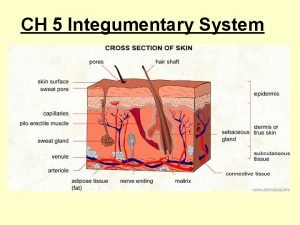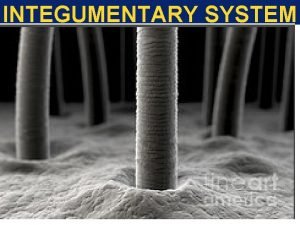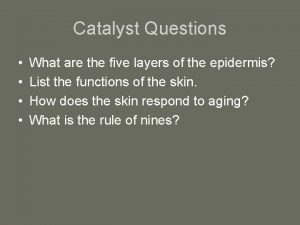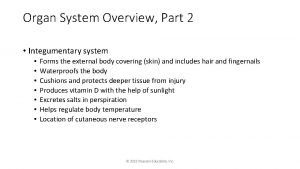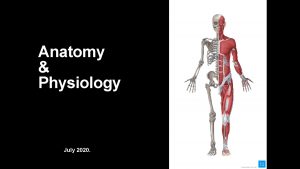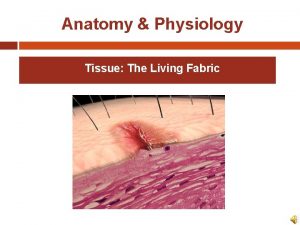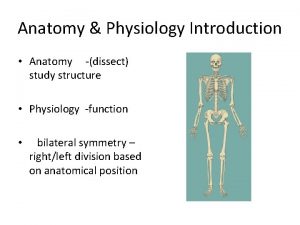Honors Anatomy Physiology INTEGUMENTARY SYSTEM ESSENTIAL QUESTION What














































































































- Slides: 110

Honors Anatomy & Physiology INTEGUMENTARY SYSTEM

ESSENTIAL QUESTION � What body? are the ways skin protects the

INTEGUMENTARY SYSTEM � functions: 1. 2. 3. 4. 5. 6. protecting the body helping to regulate body temperature allows you to sense stimuli in your environment stores blood synthesis of vit. D excretion & absorption of materials

STRUCTURE OF THE SKIN � skin = cutaneous membrane � largest organ of body � in � 2 1. 2. 3. adults: covers ~ 2 m² & weighs ~ 4. 5 – 5 kg (10 – 11 lb) parts: epidermis sub Q below dermis & not technically part of skin: contains fat (insulation), & blood vessels, nerves that supply the skin

LAYERS OF THE EPIDERMIS

EPIDERMIS � keratinzed stratified squamous epithelium � 4 main cell types: 1. keratinocytes 2. melanocytes 3. Langerhans cells 4. Merkel cells

KERATINOCYTES �~ 90% of all epidermal cells � produce fibrous protein: keratin: � protects � heat skin & underlying tissue from � microbes � chemicals � also release a water-repellant sealant from lamellar granules � decreases water entry/loss � inhibits entry of foreign materials

KERATINOCYTES

MELANOCYTES � ~8% of epidermal cells � produce melanin keratinocytes � pigment (yellow-red to brown-black) that contributes to skin color � * absorbs UV radiation � “covers” nucleus in keratinocyte


LANGERHANS CELLS � arise in red bone marrow then migrate to epidermis � easily damaged by UV radiation � function: immune response vs. microbes that invade


MERKEL CELLS � least numerous of epidermal cells (>1%) � deep in epidermis � in contact with Merkel disc (tactile disc) � together detect different aspects of touch



THIN SKIN � covers most of body � 4 layers: 1. stratum basale 2. stratum spinosum 3. stratum granulosum 4. stratum corneum

THICK SKIN � found in areas where exposure to friction is the greatest � “thick” because has 1 extra layer: � stratum lucidum (between stratgum granulosa & a thicker stratum corneum)


PSORIASIS � common & chronic skin disorder in which keratinocytes divide & move more quickly than normal from stratum basale stratum corneum � make abnl keratin flaky, silvery scales @ skin surface � most often over knees, elbows, or scalp


DERMIS � 2 nd, deeper layer of skin � composed mostly of CT � 2 regions: 1. papillary region 2. reticular region

PAPILLARY REGION OF DERMIS �~ 1/5 th of total dermis � surface area greatly increased by fingerlike structures: dermal papillae that project into epidermis � contain: � capillary loops � tactile receptors: Meissner corpuscles � free nerve endings (temp, pain, tickle, itch)


EPIDERMAL RIDGES � develop during 3 rd month of fetal development � pattern is genetically determined & unique to individuals (x identical twins) � on finger tips ridges deeper finger prints � allow you to grasp things by increasing surface area



RETICULAR REGION OF DERMIS � attached to subcutaneous layer beneath � contains: � dense irregular CT � hair follicles � sebaceous glands � sudoriferous (sweat) glands � collagen & elastic fibers (gives skin its elasticity, strength): extreme stretching striae (stretch marks)



BASIS OF SKIN COLOR � 3 1. 2. 3. pigments contribute: Melanin Hemoglobin (hgb) Carotene

MELANIN � made from a. a. tyrosine using enzyme tyrosinase then stored in organelle called a melanosome � exposure to UV light increases enzymatic activity & more (& darker) melanin produced � melanin absorbs UV radiation preventing it from damaging DNA which skin cancer

HEMOGLOBIN � in RBCs rosy color to lighter skinned individuals � blushing: due to increased blood flow (autonomic nervous system at work)

CAROTENE � yellow-orange pigment � precursor of vit. A

ALBINISM � inherited inability to produce melanin � most due to cell’s inability to produce tyrosinase

VITILIGO � partial or complete lack of melanocytes from patches of skin produces irregular white spots � ? Immune system malfunction?

SKIN COLOR AS DIAGNOSTIC CLUE � cyanotic: when blood not adequately oxygenated mucous membranes, nail beds & skin appears bluish

SKIN COLOR AS DIAGNOSTIC CLUE � jaundice: due to build up of bilirubin (yellow pigment) in skin, sclera; usually indicates liver disease

SKIN COLOR AS DIAGNOSTIC CLUE � erythema: redness of skin caused by engorgement of capillaries due to: injury, infection, inflammation, allergic reaction

SKIN COLOR AS DIAGNOSTIC CLUE � pallor: anemia paleness of the skin, seen in shock &


ACCESSORY STRUCTURES OF THE SKIN � all develop from embryonic epidermis � include: � Hair � Nails � Glands

HAIR (PILI) � present on most skin surfaces x palmar surfaces of hands, soles & plantar surfaces of feet � genetic & hormonal influences determine thickness & pattern of distribution of hair

HAIR � functions: � protection � scalp, eyebrows, eyelashes: from getting foreign objects in eyes � nose, ear canals: trap foreign objects � sensitive � touch to light touch receptors in hair root plexus

ANATOMY OF A HAIR

HAIR � composed of columns of dead, keratinized cells bonded together by extracellular proteins

ANATOMY OF A HAIR � shaft: portion of hair that projects from scalp � root: portion below scalp � follicle: surrounds root of hair � arector pili: smooth muscle extends from side of hair follicle superficial dermis

TYPES OF HAIR � lanuga: grows on fetus @ ~ 5 months fetal age; sheds b/4 birth � vellus hair: short, fine hair that grows over baby @~ 2 -3 months after birth � terminal hair: coarse hair that develops after puberty


HAIR GROWTH CYCLE

HAIR COLOR � mostly due to amt & type of melanin in keratinzed cells � dark hair has eumelanin � blondes & redheads have pheomelanin � gray: loss of melanin � white: loss of melanin + air bubbles in shaft of hair


SKIN GLANDS � exocrine 1. 2. glands ass’c with the skin: sebaceous glands sudoriferous glands � � eccrine sweat glands apocrine sweat glands



SEBACEOUS GLANDS � “oil” glands � most connected to hair follicles � rest secrete directly onto surface of skin (lips, eyelids, genitals) � secrete oily substance called sebum onto hair � keeps hair from getting brittle

ACNE � inflammation of sebaceous glands colonized with bacteria � infection cyst which destroys epidermal cells (cystic acne) � acne is not caused by eating chocolate or fried foods


SUDORIFEROUS GLANDS � sweat glands � sweat onto skin surface or hair follicles

CERUMINOUS GLANDS � modified sweat glands in external ear canal skin (sub. Q layer) � secrete cerumen (ear wax � provides a sticky barrier that impedes entrance of foreign bodies


NAILS � plates of tightly packed, hard, dead, keratinized epidermal cells that form a clear, solid covering over the dorsal surfaces of the distal portions of the 20 digits � average growth ~ 0. 04 in/wk � fingernails grow slightly faster than toe nails

FUNCTIONS OF A NAIL � help us grasp & manipulate small objects � protect ends of digits � allows scratching

PARTS OF EXTERIOR OF A NAIL

ANATOMY OF A NAIL

PARTS OF A NAIL � body: visible part � root: part buried � matrix: where cells divide to produce growth


FUNCTIONS OF THE SKIN (#7) 1. Thermoregulation � � 1. the homeostatic regulation of body temperature skin achieves this in 2 ways: sweating � 2. evaporation of sweat requires nrg (body heat) so body cools down as sweat evaporates adjusting flow of blood in dermis � � vessels dilate when body too warm vessels constrict when body too cold

FUNCTIONS OF THE SKIN 2. Blood Reservoir � skin carries ~ 8 – 10% of total blood flow in resting adult

FUNCTIONS OF THE SKIN 3. Protection � � � keratin protects underlying tissues from microbes, abrasion, heat, & chemicals lipids released retard evaporation of water from skin surface guarding vs. dehydration & retard water from entering thru skin sebum moistens skin & has antibacterial properties acidic p. H of sweat bacteriostatic melanin protects DNA in skin cells from UV damage Langerhans cells alert immune system if microbes does attack / macrophages ingest microbes

FUNCTIONS OF THE SKIN 4. Cutaneous Sensations � skin contains variety of nerve endings & receptors � touch � pressure � vibration � tickle � pain � temperature

FUNCTIONS OF THE SKIN 5. Excretion � elimination of wastes from the body � only small amt substances excreted from skin � ~400 m. L water/day ~200 m. L sweat (sedentary adult) � small amts salts, CO 2, NH 3, & urea �

FUNCTIONS OF THE SKIN 6. Absorption passage of materials from external environment body cells � absorption of water-soluble materials negligible � lipid-soluble materials do absorb: � fat-soluble vitamins (A, D, E, K) � certain drugs (can be administered transdermally) � gases: O 2 & CO 2 � toxins: acetone, CCl 4, salts of Hg, Pb, Ar, substances in poison ivy & poison oak �


FUNCTIONS OF THE SKIN 7. Synthesis of Vitamin D requires activation of a precursor molecule in the skin by UV rays in sunlight modified by enzymes in liver & kidneys producing calcitriol the most active form of vit. D � calcitriol: aids in absorption of calcium in GI tract �


SKIN WOUND HEALING � skin damage sets in motion a sequence of events that repairs the skin to as normal as it can in both structure & function � depending on depth of wound 1 of 2 processes occur � epidemal wound healing � deep wound healing

EPIDERMAL WOUND HEALING � abrasion: away � portion of skin has been scraped in response to injury: basal cells of nearby uninjured skin break contact with bm, enlarge, & migrate across the wound migration continues across wound until meet cells advancing from other side of wound � contact inhibition: cells stop migrating when touch another cell �

DEEP WOUND HEALING � when injury extends deeper than epidermis repair process more complex & scars form � healing occurs in 4 phases: 1. Inflammatory phase 2. Migratory phase 3. Proliferative phase 4. Scar formation

INFLAMMATORY PHASE � blood clot forms � loosely unites edges of wound � inflammation � vascular response � vasodilation � cellular develops & increased permeability of vessels response � phagocytic � fibroblasts WBCs (neutrophils), macrophages


MIGRATORY PHASE � clot scab � epithelial cells migrate beneath scab to bridge wound � fibroblasts begin secreting collagen & glycoproteins scar � *tissue filling wound called granulation tissue


PROLIFERATIVE PHASE � extensive growth of epithelial cells beneath scab & deposition of collagen in random patterns (fibroblasts) � growth of blood vessels


SCAR FORMATION � aka maturation phase � scab falls off � epidermis restored � collagen fibers become more organized � fibroblasts disappear � blood vessels restored to normal � scar tissue less elastic, fewer blood vessels, +/- accessory structures of skin


SCARS � fibrosis: process of scar formation � 2 types raised scars 1. hypertrophic scar � 2. scar remains w/in boundaries of wound keloid � extends boundaries of wound site

SCAR FORMATION � aka maturation phase � scab falls off � epidermis restored � collagen fibers become more organized � fibroblasts disappear � blood vessels restored to normal � scar tissue less elastic, fewer blood vessels, +/- accessory structures of skin



BURNS � tissue damage caused by excessive heat, electricity, radioactivity, or corrosive chemicals that denature proteins in skin cells � destroy skin’s ability to maintain homeostasis � graded by their severity: 1 st & 2 nd degree = partial thickness burns; 3 rd degree = full thickness

1 ST DEGREE BURNS � only epidermis is damaged � example: sunburn � symptoms: � localized � tx: redness, swelling, & pain immediate flushing with cool water (lessens pain) � healing: 3 – 6 days +/- peeling of skin � results: normal

2 ND DEGREE BURN � epidermis & upper dermis damaged, some skin function lost, ass’c structures not damaged � symptoms: � same as 1 st degree + blisters (epidermis separates from dermis due to accumulation of tissue fluid) � example: any burn with blisters

2 ND DEGREE BURNS � tx: if 2° infection: antibiotics � lasts: 3 – 4 wks with +/- scarring � AVOID: WEAR SUNSCREEN!


3 RD DEGREE BURNS � destroys epidermis, & sub. Q � no initial edema or pain or sensations (receptors destroyed) � most skin functions lost � as healing starts marked edema � regeneration: months, + scarring � tx: +/- skin grafting


SYSTEMIC EFFECTS OF A BURN � greater threat to life than burn itself � include: 1. large loss of water, plasma proteins � 2. 3. 4. 5. shock bacterial infection reduced circulation of blood decreased urine production diminshed immune response

MAJOR BURNS � used to estimate extent & severity of burns � major burn considered a 3° burn that covers > 10% of body or a 2° burn that covers > 25% of surface area of body or any 3° burn on face, hands, feet, or perineum � if burn > 70% surface area > ½ patients die

RULE OF 9’S


SKIN CANCER � 3 3. common forms: Basal cell carcinoma Squamous cell carcinoma Malignant melanoma � 1 & 2 50% more common in males 1. 2.

BASAL CELL CARCINOMA �> 78% all skin cancers � arises in cells from stratum basale � Sun-exposed � rarely areas metastasizes.

SQUAMOUS CELL CARCINOMA � ~20% of all skin cancers � arise from squamous cells in epidermis � variable tendency to metastasize

MALIGNANT MELANOMA � arise from melanocytes � ~2% of all skin cancers � deadliest form of skin cancer � spreads rapidly, can die w/in months of dx � ~1/50 Americans will develop in their lifetimes (was 1/500 in 1930’s) � increase partly due to hole in ozone layer (more UV rads) � main reason: more people spend more time in sun &/or tanning beds

MALIGNANT MELANOMA � key to successful tx is early detection � early warning signs: ABCD � A: asymetrical lesion � B: borders are irregular � C: color is uneven; may have multiple coloration � D: diameter: ordinary moles <0. 25 in (pencil eraser)



DEVELOPMENT OF THE INTEGUMENTARY SYSTEM

 Holes essential of human anatomy and physiology
Holes essential of human anatomy and physiology Anatomy and physiology unit 7 cardiovascular system
Anatomy and physiology unit 7 cardiovascular system Respiratory system of human
Respiratory system of human Appendicular skeleton pectoral girdle
Appendicular skeleton pectoral girdle Level 1 2 3 costa level of questioning
Level 1 2 3 costa level of questioning Upper respiratory diagram
Upper respiratory diagram Tattoo anatomy and physiology
Tattoo anatomy and physiology International anatomy olympiad
International anatomy olympiad Structure anatomy and physiology in agriculture
Structure anatomy and physiology in agriculture Anatomy and physiology bones
Anatomy and physiology bones Peptic ulcer anatomy
Peptic ulcer anatomy Liver physiology and anatomy
Liver physiology and anatomy Podbřišek
Podbřišek Epigastric region
Epigastric region Blood anatomy and physiology
Blood anatomy and physiology The central sulcus divides which two lobes? (figure 14-13)
The central sulcus divides which two lobes? (figure 14-13) 3 layers of muscle
3 layers of muscle Http://anatomy and physiology
Http://anatomy and physiology Chapter 1 introduction to human anatomy and physiology
Chapter 1 introduction to human anatomy and physiology Anatomy and physiology of appendicitis
Anatomy and physiology of appendicitis Aohs foundations of anatomy and physiology 1
Aohs foundations of anatomy and physiology 1 Aohs foundations of anatomy and physiology 1
Aohs foundations of anatomy and physiology 1 Anatomical planes
Anatomical planes Anatomy and physiology chapter 8 special senses
Anatomy and physiology chapter 8 special senses Chapter 13 anatomy and physiology of pregnancy
Chapter 13 anatomy and physiology of pregnancy Unit 26 self evaluation answers
Unit 26 self evaluation answers Science olympiad forensics cheat sheet
Science olympiad forensics cheat sheet Anatomy and physiology chapter 2
Anatomy and physiology chapter 2 Stomach anatomy corpus
Stomach anatomy corpus Anatomy and physiology diabetes
Anatomy and physiology diabetes Chapter 7:9 lymphatic system
Chapter 7:9 lymphatic system Anatomy and physiology coloring workbook chapter 14
Anatomy and physiology coloring workbook chapter 14 Chapter 10 blood anatomy and physiology
Chapter 10 blood anatomy and physiology Aohs foundations of anatomy and physiology 1
Aohs foundations of anatomy and physiology 1 Aohs foundations of anatomy and physiology 1
Aohs foundations of anatomy and physiology 1 Anatomy and physiology
Anatomy and physiology Anatomy and physiology chapter 15
Anatomy and physiology chapter 15 Cornell notes for anatomy and physiology
Cornell notes for anatomy and physiology Anatomy and physiology edition 9
Anatomy and physiology edition 9 Anatomy and physiology chapter 1
Anatomy and physiology chapter 1 Holes anatomy and physiology chapter 1
Holes anatomy and physiology chapter 1 Gi tract histology
Gi tract histology Anatomy and physiology
Anatomy and physiology Chapter 1 introduction to anatomy and physiology
Chapter 1 introduction to anatomy and physiology Aohs foundations of anatomy and physiology 1
Aohs foundations of anatomy and physiology 1 Aohs foundations of anatomy and physiology 1
Aohs foundations of anatomy and physiology 1 Olecranal region
Olecranal region Human physiology exam 1
Human physiology exam 1 Welcome to anatomy and physiology
Welcome to anatomy and physiology Physiology of the foot and ankle
Physiology of the foot and ankle Skin cancer
Skin cancer Pse4u
Pse4u Pancreas anatomy and physiology
Pancreas anatomy and physiology Anatomy and physiology vocabulary
Anatomy and physiology vocabulary Anatomy and physiology
Anatomy and physiology Biceps muscle names
Biceps muscle names Anatomy and physiology
Anatomy and physiology Organ orientation
Organ orientation Anatomy and physiology
Anatomy and physiology Anatomy and physiology
Anatomy and physiology Thyroid anatomy
Thyroid anatomy Dorsifelxion
Dorsifelxion Figure 11-8 arteries
Figure 11-8 arteries Anatomy and physiology
Anatomy and physiology Anatomy and physiology
Anatomy and physiology Anatomy and physiology
Anatomy and physiology Chapter 2 human reproductive anatomy and physiology
Chapter 2 human reproductive anatomy and physiology Paratubular cyst
Paratubular cyst Label o
Label o Anatomy and physiology of the eye
Anatomy and physiology of the eye Oblongata
Oblongata Irn.org anatomy and physiology
Irn.org anatomy and physiology Anatomy and physiology body parts
Anatomy and physiology body parts Unit 26 animal anatomy physiology and nutrition
Unit 26 animal anatomy physiology and nutrition Figure 14-2 digestive system
Figure 14-2 digestive system Anatomy and physiology of the retina
Anatomy and physiology of the retina Mucous connective tissue
Mucous connective tissue Anatomy and physiology of meningitis ppt
Anatomy and physiology of meningitis ppt Jeopardy anatomy and physiology game
Jeopardy anatomy and physiology game Definition of homeostasis
Definition of homeostasis Anatomy and physiology
Anatomy and physiology Anatomy and physiology trivia
Anatomy and physiology trivia Superior mouth fish
Superior mouth fish Anatomy of brain
Anatomy of brain Anatomy and physiology
Anatomy and physiology Anatomical position
Anatomical position 2012 pearson education inc anatomy and physiology
2012 pearson education inc anatomy and physiology Palatopharyngeal folds
Palatopharyngeal folds Fish anatomy and physiology
Fish anatomy and physiology Chapter 6 general anatomy and physiology
Chapter 6 general anatomy and physiology Cengage anatomy and physiology
Cengage anatomy and physiology Plamatic acid
Plamatic acid Epidermis
Epidermis Integumentary system vocabulary
Integumentary system vocabulary Integumentary system of a pig
Integumentary system of a pig Pengertian sistem integumen
Pengertian sistem integumen The integumentary system facts
The integumentary system facts The integumentary system exercise 7
The integumentary system exercise 7 Integumentary system abbreviations
Integumentary system abbreviations Integumentary system medical terminology
Integumentary system medical terminology The integumentary system
The integumentary system Integumentary system assessment
Integumentary system assessment Integumentary system analogy
Integumentary system analogy The integumentary system
The integumentary system The integumentary system
The integumentary system Figure 5-1 the components of the integumentary system
Figure 5-1 the components of the integumentary system Effects of aging on the integumentary system
Effects of aging on the integumentary system Section 36-3 the integumentary system
Section 36-3 the integumentary system Integumentary system
Integumentary system Integumentary system
Integumentary system Unit 3 integumentary system
Unit 3 integumentary system




































































































